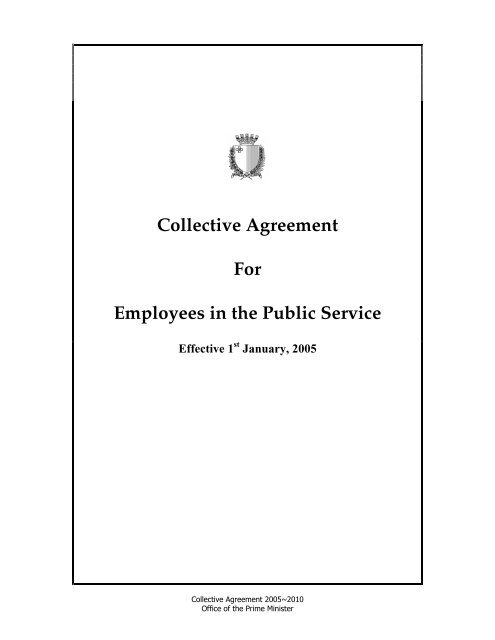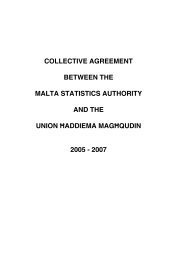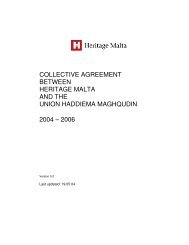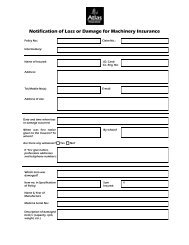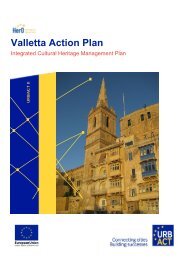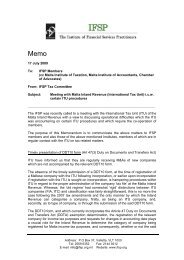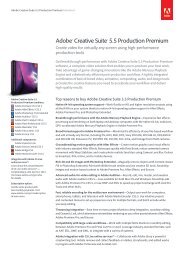Collective Agreement 2005~2010 _Final Version
Collective Agreement 2005~2010 _Final Version
Collective Agreement 2005~2010 _Final Version
You also want an ePaper? Increase the reach of your titles
YUMPU automatically turns print PDFs into web optimized ePapers that Google loves.
<strong>Collective</strong> <strong>Agreement</strong><br />
For<br />
Employees in the Public Service<br />
Effective 1 st January, 2005<br />
<strong>Collective</strong> <strong>Agreement</strong> <strong>2005~2010</strong><br />
Office of the Prime Minister
Table Of Contents<br />
Page<br />
1. Preamble 2<br />
2. Definitions 2<br />
3. Gender 3<br />
4. Future Legislation 3<br />
5. Management of Business 4<br />
6. Term of <strong>Agreement</strong> 4<br />
7. Improved Conditions 5<br />
8. Flexibility 7<br />
9. PPP Initiatives 8<br />
10.Vacation Leave 8<br />
11. Sick Leave 9<br />
12. Classification and Grading Structures 10<br />
13. Salaries 10<br />
Appendix I – PPP- Package for Public Officers 13<br />
Appendix II – Schedule of Salaries 14<br />
<strong>Collective</strong> <strong>Agreement</strong> <strong>2005~2010</strong> 1
1. Preamble<br />
1.1 Conscious of the improved conditions of service of public officers, emanating<br />
from past <strong>Collective</strong> <strong>Agreement</strong>s;<br />
and<br />
recognising that the established arrangement of negotiating a <strong>Collective</strong> <strong>Agreement</strong><br />
at regular intervals is conducive to industrial stability and competitive levels of<br />
compensation;<br />
it is the intention and purpose of the parties to this <strong>Collective</strong> <strong>Agreement</strong>:<br />
(a) to acknowledge the conditions characterising the economy on a national scale<br />
and to include measures which contribute towards the long term<br />
development of Malta and the Public Service;<br />
(b) to sustain harmonious industrial relations between the Government of Malta,<br />
the employees in the Public Service and their respective Unions;<br />
(c) to enhance the range and quality of the public services to the Government and<br />
the people through the improved productivity of public officers; and<br />
(d) to maintain the improved conditions of employment and the well-being of the<br />
employees in the Public Service;<br />
accordingly, the parties to this <strong>Agreement</strong> have agreed to the following clauses<br />
forming part of this <strong>Agreement</strong>.<br />
2 Definitions<br />
2.1 For the purpose of this <strong>Agreement</strong>:<br />
(1) "<strong>Agreement</strong>" means this <strong>Collective</strong> <strong>Agreement</strong> for employees in the Public<br />
Service entered into between the Government of Malta and the Unions<br />
representing employees in the Public Service effective 1 st January, 2005;<br />
<strong>Collective</strong> <strong>Agreement</strong> <strong>2005~2010</strong> 2
(2) “Consultation” has the same meaning as is assigned to it in the context of the<br />
Constitution of Malta and includes the process of dialogue and exchange of<br />
views between the Unions and the Employer in a manner which allows the<br />
Unions to express their position on measures envisaged by the Employer.<br />
(3) "Employer" means the Government of Malta;<br />
(4) The term "Employee" or "Employees", wherever used in this <strong>Collective</strong><br />
<strong>Agreement</strong>, mean all public officers in the Public Service covered by this<br />
<strong>Collective</strong> <strong>Agreement</strong>; and,<br />
(5) "Unions" means the:<br />
General Workers Union<br />
Malta Union of Midwives and Nurses<br />
Malta Union of Professional Psychologists<br />
Malta Union of Teachers<br />
Medical Association of Malta<br />
Union Ħaddiema Magħqudin<br />
3 Gender<br />
3.1 Words importing the masculine gender shall include females.<br />
4 Future Legislation<br />
4.1 The Employer and the Unions agree that any benefits derived from this<br />
<strong>Agreement</strong> will not be additional to any similar benefits stipulated by Law, or by the<br />
enactment of legislation during the period of validity of this <strong>Agreement</strong> provided<br />
that the employee shall receive the benefit which is more advantageous to the<br />
employee.<br />
<strong>Collective</strong> <strong>Agreement</strong> <strong>2005~2010</strong> 3
5 Management of Business<br />
5.1 Without prejudice to the provisions of this <strong>Agreement</strong>, the management of the<br />
business and the operations in general of the Employer and the authority to execute<br />
all the various duties, functions and responsibilities incidental thereto are vested in<br />
the Employer.<br />
5.2 (a) The Employer and the Unions agree to encourage the prompt and<br />
amicable resolution of any differences. Whatever practice or agreement<br />
existed prior to the difference shall continue to operate pending settlement.<br />
(b) Without prejudice to any mechanism available at Law for the<br />
reconciliation of disputes, the Employer and the Unions agree that a<br />
conciliatory structure should be put in place, composed of a Chairman and<br />
two members all three appointed by Government in consultation with the<br />
Unions. Conciliation meetings will take place after an industrial dispute is<br />
declared by the Union. Both parties shall endeavour to use this conciliatory<br />
structure before any industrial action is resorted to by the Unions.<br />
5.3 The Employer shall ensure the full compliance with all work practices by its<br />
employees.<br />
6 Term of <strong>Agreement</strong><br />
6.1 This <strong>Agreement</strong> shall remain in effect until 31 st December, 2010.<br />
6.2 (a) The Employer and the Unions shall commence discussions on issues in this<br />
<strong>Agreement</strong> not having financial implications in March 2007 and any agreement<br />
thereto shall come into effect on 1st January, 2008.<br />
<strong>Collective</strong> <strong>Agreement</strong> <strong>2005~2010</strong> 4
6.2 (b) The existing discussions with the relevant unions regarding outstanding<br />
sectoral issues shall be continued notwithstanding the entry into force of the new<br />
<strong>Collective</strong> <strong>Agreement</strong>.<br />
6.3 Negotiations in respect of the next <strong>Collective</strong> <strong>Agreement</strong>, effective 1 st January,<br />
2011, will commence in March 2010. During negotiations and until a new<br />
<strong>Agreement</strong> is signed, the conditions laid out in this <strong>Agreement</strong> shall remain in force.<br />
7 Improved Conditions<br />
7.1 The Employer and the Unions recognise the importance of Government’s<br />
objectives in its social economic plans including full employment, quality and<br />
productivity at work, social cohesion, human capital development in an inclusive<br />
labour market. Parties agree that in accordance with these objectives every effort will<br />
be made to implement measures which ensure enhanced efficiency, improved skill<br />
levels and greater inclusiveness.<br />
7.2 The Management and Personnel Office together with the Ministries and<br />
Departments will support and encourage initiatives that :-<br />
• promote and maintain a high degree of physical, mental, and social<br />
well being of public officers in all occupations;<br />
• further the participation of female employees, in particular in the<br />
professional, vocational and managerial grades;<br />
• enhance as far as possible the status of disabled employees and<br />
through reasonable accommodation continue to facilitate their entry<br />
and opportunities for advancement in the Public Service. Government<br />
departments will endeavour to ensure that all premises are accessible<br />
to disabled employees;<br />
<strong>Collective</strong> <strong>Agreement</strong> <strong>2005~2010</strong> 5
7.3 In accordance with Government policy to continue to promote family friendly<br />
measures which enable employees to combine their work and family responsibilities,<br />
the Employer shall introduce more flexible parameters in the utilisation of unpaid<br />
parental leave and reduced hours as follows provided that, in consonance with<br />
existing practices, the applicability of this clause shall be subject to the exigencies<br />
and nature of the functions of the different departments as established in the Public<br />
Service Management Code:<br />
(a) public officers shall be allowed one (1) year unpaid parental leave to take care of<br />
their own children who are under six (6) years of age. This leave may be availed of in<br />
respect of each child. They shall be able to choose to utilise 3, 6, or 9 months instead<br />
of the whole 12 months period. The one-year leave may be shared by both parents<br />
who must declare their option when they apply for leave. Any outstanding leave not<br />
utilised may not be availed of at a later date;<br />
(b) in addition, public officers shall be allowed a once only maximum period of five<br />
(5) years unpaid parental leave, instead of the current once only three (3) years<br />
maximum, to be utilised either as a whole period or reduced by multiples of 3<br />
months to take care of their own children who are under six (6) years of age. If the<br />
five (5) years are not availed of in one whole period, the balance may only be taken<br />
for the care of another child/children. Leave taken from this entitlement of five (5)<br />
years may be shared by both parents, in respect of each child. The periods of leave to<br />
be taken must be declared, and any changes may only be made by giving 3 months’<br />
notice;<br />
(c) public officers who are in the course of a period of unpaid parental leave or<br />
public officers who would, if they applied, have been entitled to parental leave shall<br />
be allowed to work on a reduced time-table until the child reaches the age of twelve<br />
(12) years.<br />
(d) the term child/children mentioned in paragraphs (a) (b) and (c) above refers to<br />
both natural and adopted child/children.<br />
<strong>Collective</strong> <strong>Agreement</strong> <strong>2005~2010</strong> 6
8 Flexibility<br />
8.1 The Employer shall continue to facilitate the implementation of existing flexibility<br />
measures and to further explore the possible introduction of other cost effective<br />
flexibility arrangements such as flexitime, job sharing and teleworking, as and where<br />
feasible and appropriate.<br />
8.2 The Employer and the Unions recognise the need of flexibility in work schedules<br />
and staff deployment in order to ensure the effective and efficient delivery of service,<br />
and in order to achieve this objective;<br />
(a) the Employer shall take effective steps to introduce new schedules according<br />
to the exigencies of the Service. Such steps in particular shall be taken where<br />
public services to the business and tourism sectors are involved;<br />
and<br />
(b) Changes with respect to appropriate work schedules to be adopted by the<br />
Employer in particular Ministries, Divisions, Departments or Units shall be<br />
thoroughly discussed between the Employer and the Union/Unions concerned<br />
for at least six months before such changes are introduced and brought into<br />
force.<br />
Without prejudice to the above, the Employer or the Union may request the<br />
assistance of the conciliatory structure established under Clause 5.2 (b) not<br />
earlier than three months after the initiation of such discussions to mediate any<br />
difference that might arise.<br />
The Unions shall not be precluded from taking those actions permitted by law<br />
that they may deem fit following the conclusion of the discussions referred to<br />
above in this paragraph.<br />
<strong>Collective</strong> <strong>Agreement</strong> <strong>2005~2010</strong> 7
8.3 In those areas in the Public Service where the Employer identifies cases of under<br />
employment, the Employer and the Unions recognise the continuing and increasing<br />
need to lend support to retraining and multi-skilling initiatives. In this context the<br />
Employer, following consultation with the Unions, may deploy employees in the<br />
Public Service and/or public sector as required within the parameters of their<br />
appointment on different work schedules and different areas of work according to<br />
operational requirements and to specific assignments.<br />
8.4 The Employer and the Unions agree to introduce modern mechanical and/or<br />
electronic systems for the purpose of security, recording attendance, salary<br />
computation and audit trails. Where such systems are introduced in a particular<br />
place of work, all employees therein shall be required to make use of such systems.<br />
The Employer shall endeavour to introduce these systems in all its places of work by<br />
31st December, 2007 but not later than 31st December, 2010.<br />
9 PPP Initiatives<br />
9.1 The Employer will explore opportunities with a view to putting in practice other<br />
Public Private Partnership projects or other similar initiatives. Parties agree that the<br />
terms and conditions of employees deployed on such projects, as shown in<br />
Appendix I, will serve as the basis for further consultation prior to the<br />
implementation of new projects.<br />
10 Vacation Leave<br />
10.1 With effect from 1st January, 2006 every employee shall be entitled to paid<br />
annual leave of the equivalent in hours of four weeks and four working days<br />
calculated on the basis of a forty-hour working week, and an eight-hour working<br />
day (that is, on the basis of 192 hours) exclusive of the intervals for breaks, meals<br />
and rest:<br />
Provided that in cases where the average weekly working time, calculated on<br />
the basis of a reference period of seventeen weeks, is below or exceeds forty hours<br />
<strong>Collective</strong> <strong>Agreement</strong> <strong>2005~2010</strong> 8
per week, the annual leave entitlement in hours, irrespective of the number and<br />
duration of weekly attendances, shall be adjusted accordingly as a percentage of the<br />
said 192 hours on the basis of the following equation;<br />
average hours worked per week<br />
_______________________________________<br />
X 192 hours<br />
40 hours<br />
10.2 Notwithstanding the provisions of the preceding paragraph, a serving public<br />
officer, who on the 31 st December 2005 was working on a shift roster in a particular<br />
Division/Department, shall continue to enjoy on a personal basis the present leave<br />
entitlement equivalent in hours on the particular shift roster on which the serving<br />
officer is currently deployed and this provision shall continue to apply as long as the<br />
serving officer is deployed on such rosters within the same Division/Department<br />
where he/she is currently serving. The provisions of this clause cannot be used as a<br />
precedent for work practices not covered by this paragraph.<br />
10.3 The leave entitlement of employees is to be availed of in whole<br />
days/attendances computed in hours:<br />
Provided further that employees may avail themselves of shorter absences up<br />
to a maximum of 32 hours and a minimum of 4 hours at a time (8 absences of 4<br />
hours, or lesser absences of more hours).<br />
10.4 The pro rata leave entitlement of employees on reduced hours shall be<br />
computed in hours on the basis of paragraph 10.1.<br />
11 Sick Leave<br />
11.1 The Employer and the Unions, having considered that the ‘pre-retirement<br />
leave’ concession did not achieve the desired reduction in sick leave, agree that the<br />
<strong>Collective</strong> <strong>Agreement</strong> <strong>2005~2010</strong> 9
scheme introduced with effect from 1 st January, 1999, will be revised as follows with<br />
effect from 1 st January, 2006:<br />
11.2 Employees would be entitled to avail themselves of unutilised sick leave on full<br />
pay as “pre-retirement leave” on the basis of one (1) day’s leave for every four (4) of<br />
unutilised sick leave, immediately preceding their retirement from the service on<br />
reaching the age limit, provided that a period of “pre-retirement leave” must be<br />
continuous and cannot exceed a total of three (3) calendar months. Employees<br />
intending to avail themselves of such pre-retirement leave shall give three months<br />
advance notice to the Employer.<br />
11.3 To qualify for “pre-retirement leave” employees will have to accumulate an<br />
average of fifteen (15) working days of unutilised sick leave per calendar year in<br />
employment. The maximum amount of unutilised sick leave which an employee<br />
will be entitled to accumulate for the purpose of this arrangement will be limited to<br />
seven (7) working days per calendar year (i.e. l/4 of 28 days).<br />
11.4 The conditions, as established in the Public Service Management Code, for<br />
officers on a Performance <strong>Agreement</strong> who avail themselves of pre-retirement leave<br />
shall continue to apply.<br />
12 Classification and Grading Structures<br />
12.1 The Employer and the Unions agree that the established benchmarks shall not<br />
be disturbed. The salary structures in the current Public Service Classification<br />
<strong>Agreement</strong>s shall continue to respect these benchmarks.<br />
13 Salaries<br />
13.1 The parties agree that salary scales payable to employees during the years 2005,<br />
2006, 2007, 2008, 2009 and 2010 will be as shown in Appendix II to the <strong>Agreement</strong>.<br />
<strong>Collective</strong> <strong>Agreement</strong> <strong>2005~2010</strong> 10
13.2 The salary scales for the years 2006, 2007, 2008, 2009 and 2010 as shown in<br />
Appendix II are inclusive of any cost of living adjustments (COLA) which the<br />
Government may award in respect of these years. Provided that in the event that in<br />
respect of a particular year the COLA is more than Lm1.50 per week (Lm78 per<br />
annum), employees not receiving the full equivalent of the COLA through the<br />
<strong>Collective</strong> <strong>Agreement</strong> increase shall receive the difference, for that particular year in<br />
the form of a cash payment. Provided further that the cash payment shall cease to be<br />
paid if the cumulative <strong>Collective</strong> <strong>Agreement</strong> increases, for the years prior the year a<br />
<strong>Collective</strong> <strong>Agreement</strong> increase is due, is greater or equal to the cumulative COLA for<br />
those same years.<br />
13.3 Employees who entered the Service after 5 th December, 2002, and are in salary<br />
scales 14 to 20 shall start to benefit from the new salaries, as shown in Appendix II,<br />
with effect from 1 st January, 2007.<br />
<strong>Collective</strong> <strong>Agreement</strong> <strong>2005~2010</strong> 11
COLLECTIVE AGREEMENT FOR PUBLIC SERVICE EMPLOYEES<br />
EFFECTIVE 1ST JANUARY, 2005<br />
For the Government<br />
For the Unions<br />
____________________<br />
G Grima<br />
Principal Permanent Secretary<br />
____________________<br />
J Attard Sultana<br />
Secretary<br />
Public Sector Section<br />
General Workers’ Union<br />
____________________<br />
J Izzo<br />
Permanent Secretary<br />
Office of the Prime Minister<br />
____________________<br />
R Cini<br />
President<br />
Malta Union of Midwives and<br />
Nurses<br />
____________________<br />
B Caruana<br />
President<br />
Malta Union of Professional<br />
Psychologists<br />
____________________<br />
J Bencini<br />
President<br />
Malta Union of Teachers<br />
___________________<br />
M Balzan<br />
General Secretary<br />
Medical Association of Malta<br />
___________________<br />
G Tanti<br />
President<br />
Union Ħaddiema Magħqudin<br />
Date: 26 th October, 2005<br />
<strong>Collective</strong> <strong>Agreement</strong> <strong>2005~2010</strong> 12
APPENDIX I<br />
PUBLIC PRIVATE PARTNERSHIP SCHEME<br />
Package for Public Officers<br />
The following administrative arrangements are applicable for Public Officers deployed on Public Private<br />
Partnership Government projects. These arrangements make the necessary safeguards and provide for benefits<br />
and incentives as follows:-<br />
• Retention of all present and future rights to appointments in the Public Service, privileges, and<br />
pensionability arrangements;<br />
• Guarantee of conditions of work no worse than those obtaining at present;<br />
• Payment of basic salary guaranteed through linkage with the Treasury which will continue to compute and<br />
indemnify salaries;<br />
• A flexibility bonus of 10% to 25% on basic salary may be paid by the Government for flexibility in<br />
working arrangements such as duties beyond those expected from the substantive grade, and for working to<br />
flexible time-tables and outside established hierarchical structures. Guidelines for the award of bonuses<br />
will be drawn up;<br />
• Cash bonuses may also be paid by the management of the partnership related to performance, responsibility<br />
and multitasking;<br />
• Opportunities will be provided for retraining and reskilling;<br />
• Participation in incentive schemes may be administered by the management of the partnership;<br />
• Though the performance of an employee’s substantive duties whilst on a PPP initiative on Government<br />
projects is mandatory, participation on projects of the private partner beyond the normal working week is<br />
voluntary;<br />
• Assignment on higher duties for higher pay may be made by the management of the partnership on the<br />
basis of merit irrespective of grade structure and seniority, resulting in a changing and less rigid chain of<br />
command;<br />
• Employees promoted following a PSC call may opt to remain in the new grade with the partnership;<br />
• The management of the partnership may summarily deal with employees for minor misconduct as defined<br />
in the PSC Disciplinary Regulations 1999 and may also effect a reduction from allowances/bonuses<br />
payable over and above the basic salary;<br />
• Serious breaches of discipline will continue to be dealt with under the PSC Disciplinary Regulations 1999;<br />
• Vacancies already identified within a Unit immediately prior to its function migrating to private<br />
management under a PPP project, will be proceeded with subject to parameters. If the vacancy is filled by<br />
an employee from outside the Unit, the appointment will be subject to joining the Unit under private<br />
management. Vacancies arising within the Unit through wastage, promotion, etc during the course of the<br />
Project will be filled in the usual manner;<br />
• Employees who perform satisfactorily in a grade higher than the substantive grade for a period of ten years<br />
will, apart from the higher remuneration associated with the higher duties, be also awarded a salary scale<br />
higher than that to which the employee is entitled by virtue of the substantive grade, on a personal basis;<br />
• If the partnership ceases to operate, the employee will return to the Public Service in the substantive grade.<br />
<strong>Collective</strong> <strong>Agreement</strong> <strong>2005~2010</strong> 13
APPENDIX II<br />
SCHEDULE OF SALARIES APPLICABLE TO PUBLIC OFFICERS FOR YEARS 2005 to 2010<br />
Scale<br />
2005 2006 2007 2008 2009 2010<br />
1 Lm13,522 Lm13,697 Lm14,102 Lm14,847 Lm15,610 Lm16,392<br />
2 Lm12,470 Lm12,631 Lm13,004 Lm13,683 Lm14,379 Lm15,092<br />
3 Lm11,420 Lm11,567 Lm11,908 Lm12,521 Lm13,149 Lm13,793<br />
4 Lm10,370 Lm10,503 Lm10,811 Lm11,359 Lm11,919 Lm12,493<br />
5<br />
Lm7,521 x 275 –<br />
Lm9,171<br />
Lm7,638 x 275 –<br />
Lm9,288<br />
Lm7,910 x 275 –<br />
Lm9,560<br />
Lm8,383 x 275 –<br />
Lm10,033<br />
Lm8,868 x 275 –<br />
Lm10,518<br />
Lm9,363 x 275 –<br />
Lm11,013<br />
6<br />
Lm7,039 x 256 –<br />
Lm8,575<br />
Lm7,148 x 256 –<br />
Lm8,684<br />
Lm7,402 x 256 –<br />
Lm8,938<br />
Lm7,836 x 256 –<br />
Lm9,372<br />
Lm8,281 x 256 –<br />
Lm9,817<br />
Lm8,736 x 256 –<br />
Lm10,272<br />
7<br />
Lm6,611 x 228 –<br />
Lm7,979<br />
Lm6,713 x 228 –<br />
Lm8,081<br />
Lm6,948 x 228 –<br />
Lm8,316<br />
Lm7,345 x 228 –<br />
Lm8,713<br />
Lm7,752 x 228 –<br />
Lm9,120<br />
Lm8,167 x 228 –<br />
Lm9,535<br />
8<br />
Lm6,211 x 209 –<br />
Lm7,465<br />
Lm6,306 x 209 –<br />
Lm7,560<br />
Lm6,526 x 209 –<br />
Lm7,780<br />
Lm6,890 x 209 –<br />
Lm8,144<br />
Lm7,263 x 209 –<br />
Lm8,517<br />
Lm7,644 x 209 –<br />
Lm8,898<br />
9<br />
Lm5,841 x 192 –<br />
Lm6,993<br />
Lm5,930 x 192 –<br />
Lm7,082<br />
Lm6,135 x 192 –<br />
Lm7,287<br />
Lm6,471 x 192 –<br />
Lm7,623<br />
Lm6,814 x 192 –<br />
Lm7,966<br />
Lm7,165 x 192 –<br />
Lm8,317<br />
10<br />
Lm5,507 x 175 –<br />
Lm6,557<br />
Lm5,590 x 175 –<br />
Lm6,640<br />
Lm5,782 x 175 –<br />
Lm6,832<br />
Lm6,090 x 175 –<br />
Lm7,140<br />
Lm6,405 x 175 –<br />
Lm7,455<br />
Lm6,726 x 175 –<br />
Lm7,776<br />
11<br />
Lm5,193 x 161 –<br />
Lm6,159<br />
Lm5,271 x 161 –<br />
Lm6,237<br />
Lm5,451 x 161 –<br />
Lm6,417<br />
Lm5,734 x 161 –<br />
Lm6,700<br />
Lm6,023 x 161 –<br />
Lm6,989<br />
Lm6,318 x 161 –<br />
Lm7,284<br />
12<br />
Lm4,889 x 152 –<br />
Lm5,801<br />
Lm4,967 x 152 –<br />
Lm5,879<br />
Lm5,136 x 152 –<br />
Lm6,048<br />
Lm5,395 x 152 –<br />
Lm6,307<br />
Lm5,659 x 152 –<br />
Lm6,571<br />
Lm5,928 x 152 –<br />
Lm6,840<br />
13<br />
Lm4,599 x 144 –<br />
Lm5,463<br />
Lm4,677 x 144 –<br />
Lm5,541<br />
Lm4,836 x 144 –<br />
Lm5,700<br />
Lm5,072 x 144 –<br />
Lm5,936<br />
Lm5,313 x 144 –<br />
Lm6,177<br />
Lm5,559 x 144 –<br />
Lm6,423<br />
14<br />
Lm4,331 x 136 –<br />
Lm5,147<br />
Lm4,409 x 136 –<br />
Lm5,225<br />
Lm4,558 x 136 –<br />
Lm5,374<br />
Lm4,770 x 136 –<br />
Lm5,586<br />
Lm4,987 x 136 –<br />
Lm5,803<br />
Lm5,208 x 136 –<br />
Lm6,024<br />
15<br />
Lm4,099 x 128 –<br />
Lm4,867<br />
Lm4,177 x 128 –<br />
Lm4,945<br />
Lm4,316 x 128 –<br />
Lm5,084<br />
Lm4,502 x 128 –<br />
Lm5,270<br />
Lm4,690 x 128 –<br />
Lm5,458<br />
Lm4,882 x 128 –<br />
Lm5,650<br />
16<br />
Lm3,924 x 97 –<br />
Lm4,603<br />
Lm4,002 x 97 –<br />
Lm4,681<br />
Lm4,133 x 97 –<br />
Lm4,812<br />
Lm4,292 x 97 –<br />
Lm4,971<br />
Lm4,453 x 97 –<br />
Lm5,132<br />
Lm4,617 x 97 –<br />
Lm5,296<br />
17<br />
Lm3,725 x 90 –<br />
Lm4,355<br />
Lm3,803 x 90 –<br />
Lm4,433<br />
Lm3,926 x 90 –<br />
Lm4,556<br />
Lm4,061 x 90 –<br />
Lm4,691<br />
Lm4,198 x 90 –<br />
Lm4,828<br />
Lm4,337 x 90 –<br />
Lm4,967<br />
18<br />
Lm3,544 x 82 –<br />
Lm4,118<br />
Lm3,622 x 82 –<br />
Lm4,196<br />
Lm3,737 x 82 –<br />
Lm4,311<br />
Lm3,847 x 82 –<br />
Lm4,421<br />
Lm3,959 x 82 –<br />
Lm4,533<br />
Lm4,072 x 82 –<br />
Lm4,646<br />
19<br />
Lm3,366 x 77 –<br />
Lm3,905<br />
Lm3,444 x 77 –<br />
Lm3,983<br />
Lm3,552 x 77 –<br />
Lm4,091<br />
Lm3,642 x 77 –<br />
Lm4,181<br />
Lm3,733 x 77 –<br />
Lm4,272<br />
Lm3,825 x 77 –<br />
Lm4,364<br />
20<br />
Lm3,197 x 73 –<br />
Lm3,708<br />
Lm3,275 x 73 –<br />
Lm3,786<br />
Lm3,353 x 73 –<br />
Lm3,864<br />
Lm3,431 x 73 –<br />
Lm3,942<br />
Lm3,509 x 73 –<br />
Lm4,020<br />
Lm3,587 x 73 –<br />
Lm4,098<br />
<strong>Collective</strong> <strong>Agreement</strong> <strong>2005~2010</strong> 14


